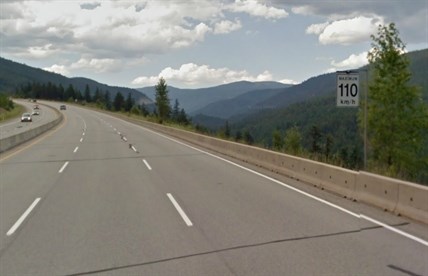
The Okanagan Connector is one of the few highways in the province with a 110 km/h speed limit.
Image Credit: Google Maps
October 05, 2013 - 10:28 AM
KAMLOOPS, B.C. - British Columbia is launching a review of speed limits on longer stretches of highways between communities, mostly in rural parts of the province.
Transportation Minister Todd Stone says the public is invited to provide input on speed limits through eight forums around B.C. and through a website.
The forums starting next month will be held in Kamloops, Kelowna, Cranbrook, Prince George, Dawson Creek, Nanaimo, Chilliwack and Vancouver. No exact dates or locations have been set yet.
Stone says the Coquihalla Highway and the Trans-Canada Highway could be prime candidates for a change in speed limits, but that provincial highways that run through major urban centres will not be part of the review.
He says research around the world suggests drivers who don't keep up with the flow of traffic, not speeders, cause accidents, so the review may result in increased speed limits in some areas and reductions in others by next spring.
Along with public input, the Transportation Ministry will collect data from various groups including the RCMP, the Union of B.C. Municipalities, the Insurance Corp. of B.C. and the trucking association.
Speed-Limit Review:
* Public input will be sought on which highway corridors should be considered.
* The technical review includes an assessment of current travel speeds, safety history, highway alignment and traffic volume and mix.
* The review will also consider the feasibility of speed-management strategies such as seasonal speed limits and speed limits by vehicle type.
Slower Vehicles Review:
* Vehicles impeding other vehicles, (e.g. in the left lane, recreational vehicles, when towing, etc.) reduce the efficiency of the highway system and can cause driver frustration.
* Public input will be sought on what is considered a slow vehicle and corridors of concern.
* The review will examine various means of ensuring the safety of slower drivers while improving the efficiency of the highway. Best practices in signing, public education, enforcement and availability of pull-out facilities will be reviewed.
Wildlife-Corridor Review:
* Wildlife on the highway can pose a serious hazard to motorists in British Columbia.
* Public input will be sought on corridors of concern and areas where warnings could be enhanced.
* The review will identify practices that could be implemented to reduce wildlife collisions, and on which highway segments. Examples
of key areas for examination include: advisory signs, wildlife-advisory speeds and the use of advanced technologies to detect and deter wildlife.

A driver's perspective of Highway 97-C, the Okanagan Connector.
Image Credit: Flickr
This review will build on the work done during the last review in 2003.
Last month, Ian Tootill of Sense B.C. posted a video to the organization's website. It's called "Speed Kills Your Pocketbook."
Tootill co-founded the website years ago in an effort to, "support speed limits that reflect the upper limit of safe travel speeds to ensure the reasonable and safe actions of the majority of drivers are legal." The video has recieved over 1.1M views so far on YouTube. No matter what side of the speed limit issue you fall, the video is worth watching.
Video Credit: YouTube
Speed Kills Your Pocketbook
News from © The Canadian Press , 2013